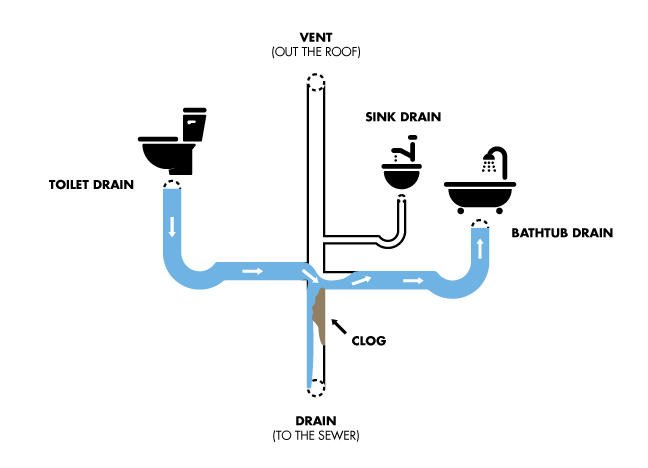Clogged Drain? How To Fix It & When To Call A Plumber

Are you dealing with clogged drains? From unpleasant odors to poor water flow, clogs have many consequences. Over time, clogs can build up, leading to long-term pipe damage. Not only does this disrupt your home's water supply, but it can also be costly. The good news is there are ways to unclog your drains before the problems grow. In this blog, we'll go over everything you need to know about fixing a clogged drain, including the following:
- Assess the severity of the clog
- DIY unclog methods
- When to call a plumber for your clogged drain
Keep reading to discover at-home methods for unclogging your drain and whether you need to contact a plumber.
Got a clogged drain?
Our plumbers have decades of industry experience and can unclog your drain in no time. Call us at (248) 644-7810 or schedule an appointment online for a complimentary estimate.
Assess the Severity of the Clog
The first step is determining how serious the clog is. Here are some key ways to help assess a clog's severity:
- Observe your drainage: Observe the quality of your water drainage. The clog is probably minor if the water is slightly slower than usual. However, if it's significantly slower — or barely draining — you might have a more major clog on your hands.
- Listen for odd noises: If your drain emits a gurgling sound, that indicates there is air trapped inside due to a significant clog.
- Test multiple drains: Test multiple faucets and drains throughout your home to determine how widespread the problem is. If several drains are clogged, there may be an issue with your entire plumbing system.
If you suspect the clog is minor, you can try to unclog the drain yourself.
DIY Unclog Methods
Here are some DIY methods for unclogging a drain.
Plunging
The most straightforward way to get rid of a clog is by plunging. First, ensure you're using the correct plunger — there are different plungers for sinks and toilets. Once you have the right appliance, position it over the drain. There should be enough water to fill the inside of the plunger; if your water levels are low, you can add some. Then, bring the plunger down and cover the drain. The suction should make it stick over the drain.
The next step involves actually plunging or moving the plunger up and down. The exact plunging motion varies depending on the type of drain — for example, you should plunge faster with bathtubs and sinks than with toilets. After about 20 seconds, remove the plunger and check if the water is draining.
Hot Water Flushing
Another way to clear drains is through hot water flushing. This method is most effective for clogs caused by substance buildup (such as soap scum, food, and grease). Start by filling a kettle or pot with water and boiling it. When the water is ready, wait a few minutes before pouring it down your drain.
The high temperature, as well as the force of the water, can break up the substances and force them down the pipe. Remember that you may have to do two or three rounds of hot water flushing to dislodge a clog.
Use a Snake or Auger
Use a plumbing snake or auger if the above methods don't work. Unlike plungers, you'll have to navigate the tool into the drain. First, remove the drain stopper, then carefully steer the snake into the drain. As you move the snake further down, it may make contact with the clog. When this happens, rotate the plumbing snake to break up the substances.
Keep rotating the snake and moving it further down. If it's working, you may feel less and less resistance. If you think you've eliminated the clog, bring the snake back out and clean it. Then, turn on the tap to see if the water flows more freely.
Natural Drain Unclogging Remedies
Not everyone knows how to effectively use a plunger or plumbing snake. If you don't want to use these appliances and the boiling water trick doesn't work, consider trying these natural remedies:
- Hot water and salt: Did you know that salt helps scrape away materials clinging to the interior of your pipes? Dissolving a quarter cup of salt in your hot water can be more effective than using hot water alone.
- Baking soda and vinegar: If you've ever mixed baking soda with vinegar, you know it creates a foaming solution. This solution can actually help dislodge clogs. To avoid making a mess in your kitchen, pour about half a cup of baking soda down the drain. Then, follow this with a cup of vinegar. After about 15 minutes, flush it with hot water.
- Baking soda and lemon juice: Don't have vinegar on your hands? You can substitute it for half a cup of lemon juice or salt. Wait about 30 minutes before flushing with hot water.
When to Call a Plumber for Your Clogged Drain

While some clogs can be fixed with these remedies, others will need professional help. Here are some signs you should call a plumber:
- The DIY remedies don't work
- You have multiple clogged drains
- You experience frequent blockages
- The water is blocked completely
If you're looking for a professional plumber, our team is here to help. With our experience and dedication, we'll have your systems back up and running within 24 hours.
Contact Us and Unclog Your Drain Today!
Since 1937, the Thornton & Grooms team has delivered high-quality plumbing services to homeowners at a fair price. No matter what the cause of your clogged drain is, we'll get to the root of it. Call us at (248) 644-7810 or schedule an appointment online for a complimentary estimate.
- Tagged:
- Troubleshooting
